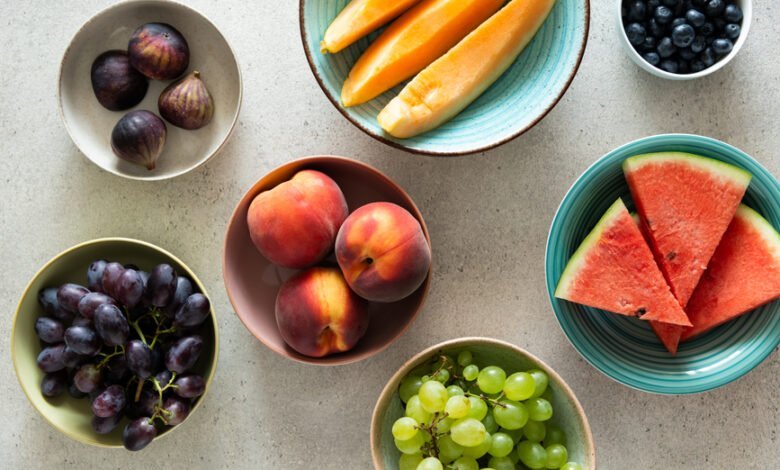Types and Best Food Sources

To learn more about this powerful plant nutrient and the best ways to find it in the foods we eat, we caught up with Melanie Murphy Richter, RDN, a registered dietitian and neuronutritionist.
What are phytonutrients?
Phytonutrients (aka phytochemicals or antioxidants) are compounds found on the surface of plants that act as a protective barrier against external threats, such as bacteria, viruses, and fungi. However, consuming phytonutrients can also provide protective benefits for humans.
“When humans consume phytonutrients through fruits, vegetables, nuts, seeds, and whole grains, they play powerful roles as antioxidants to help us fight against damage from the environment, oxidative stress, ultraviolet (UV) damage, or even illness,” Richter says. When you’re heavily exposed to pollution, smoking, UV rays, and stress, it can increase the number of free radicals in your body, which can lead to cell damage; this is known as oxidative stress.
According to Richter, there are six main types of phytonutrients: flavonoids, carotenoids, polyphenols, phytosterols, phytoestrogens, and glucosinolates. “Each class of phytonutrient has its own beneficial superpowers and can range from anti-inflammatory effects, immune health benefits, improvements in heart health, potential cancer-fighting properties, and can also positively impact digestive, skin, and bone health too,” she says. Fortunately for us, phytonutrients naturally exist in many of the fruits and vegetables we already consume regularly.
6 main types of phytonutrients
1. Flavonoids
According to Richter, flavonoids—including flavonols, a subclass of flavonoids—are extremely beneficial for heart health. “Flavonoids can help reduce blood pressure and cholesterol,” she says. Studies show that consuming foods rich in flavonoids—such as cocoa, apples, tea, citrus fruits, and berries—can have a potentially positive effect 1on high blood pressure and endothelial dysfunction (constriction of blood flow).
Food sources: Berries, green tea, onions, cocoa, apples, and oranges (and other citrus)
2. Carotenoids
Carotenoids are another potent phytonutrient that can support eye health 2and prevent eye-related disease, says Richter. “It’s also what gives orange, red, and yellow plant foods their bright coloring,” she adds. Research also shows a positive correlation between consuming carotenoid-rich foods and cancer prevention3, this is likely due to the presence of lutein and zeaxanthin—two powerful carotenoid pigments.
Food sources: Bell peppers, carrots, tomatoes, and pumpkins
3. Polyphenols
Polyphenols contain powerful antioxidants that help reduce overall inflammation in the body. They can also support brain health 4and help prevent certain types of neurodegenerative diseases by protecting against free-radical damage. In fact, consuming polyphenol-rich foods has even been linked to boosting longevity.
Food sources: Dark chocolate, red wine, berries, pears, and grapes
4. Phytosterols
According to Richter, phytosterols can help regulate cholesterol levels. “Phytosterols work strongly against unhealthy cholesterol levels, which makes them beneficial for the heart,” she says. A 2017 study showed that consuming two grams of phytosterols per day5 can potentially help lower low-density lipoprotein cholesterol (LDL-cholesterol) by eight to 10 percent.
Food sources: Nuts, seeds, and legumes
5. Phytoestrogens
Phytoestrogens are powerful hormone-balancing compounds. “When consumed, they can play the role of estrogen in the body, helping women better regulate their cycles 6throughout their lifespan,” Richter says.
Food sources: Flaxseeds, edamame, tofu, and certain whole grains like barley
6. Glucosinolates
“Glucosinolates are wonderful detoxifiers. They can help remove harmful substances in the body to potentially reduce the risk of cancer7,” Richter says. In fact, they’re considered one of the best foods for colon health.
“Broccoli, cauliflower, Brussels sprouts, kale, and other cruciferous vegetables contain compounds called glucosinolates, which are broken down into biologically active compounds that have been shown to inhibit the development of colon cancer cells,” registered dietitian and oncology coach Nichole Andrews, RDN, previously shared with Well+Good.
Food sources: Cruciferous veggies like cauliflower, broccoli, cabbage, and kale
FAQ
Are phytonutrients and antioxidants the same thing?
Although phytonutrients and antioxidants are very similar in many ways, they aren’t exactly the same. “Many phytonutrients like flavonoids and carotenoids, for instance, have antioxidant properties by which they can help to neutralize free radicals and oxidative damage from the body,” Richter says. However, these two compounds are different in the sense that phytonutrients are exclusively found in plant-based foods, whereas antioxidants can also be found in non-plant sources.
What food has the most phytonutrients?
Colorful fruits and vegetables typically contain the highest concentration of antioxidant-rich phytonutrients, Richter says. In fact, phytonutrients are what give these foods their vibrant coloration and pigment—a telltale sign of high antioxidant properties.
However, in order to reap the benefits of phytonutrients, Richter says consuming these brightly colored plants in their entirety is a must. “Be sure to eat these foods with their skins on, as the biggest quantity is found within the skins of these foods,” she says.
That said, vibrantly-colored fruits and veggies aren’t the only phytonutrient powerhouses. Richter says nuts, seeds, legumes, and even chocolate (!) and certain types of tea are also great sources of phytonutrients.
How many phytonutrient-rich foods should you eat daily?
Although Richter points out that there is currently no set recommendation of phytonutrient amounts to consume daily, she says it’s best to try to eat as many phytonutrient-rich foods as possible for overall immune and health support. “You can do this by consciously choosing a more plant-based diet and focusing on eating a variety of different foods each day,” she says.
However, this should come as no surprise, considering consuming a wide array of plants is often considered a key cornerstone of longevity. “The healthiest diets focus on consuming a variety of different types of foods every day,” Richter agrees. By incorporating these six main types of phytonutrients in your daily routine, you’re better able to provide different benefits to the body. “The more variety we consume, the better, comprehensive health benefits we’ll receive,” Richter says.
Well+Good articles reference scientific, reliable, recent, robust studies to back up the information we share. You can trust us along your wellness journey.
-
Rees, Amy et al. “The Effects of Flavonoids on Cardiovascular Health: A Review of Human Intervention Trials and Implications for Cerebrovascular Function.” Nutrients vol. 10,12 1852. 1 Dec. 2018, doi:10.3390/nu10121852 -
Abdel-Aal, El-Sayed M et al. “Dietary sources of lutein and zeaxanthin carotenoids and their role in eye health.” Nutrients vol. 5,4 1169-85. 9 Apr. 2013, doi:10.3390/nu5041169 -
Koklesova, Lenka et al. “Carotenoids in Cancer Apoptosis-The Road from Bench to Bedside and Back.” Cancers vol. 12,9 2425. 26 Aug. 2020, doi:10.3390/cancers12092425 -
Ammar, Achraf et al. “Effects of Polyphenol-Rich Interventions on Cognition and Brain Health in Healthy Young and Middle-Aged Adults: Systematic Review and Meta-Analysis.” Journal of clinical medicine vol. 9,5 1598. 25 May. 2020, doi:10.3390/jcm9051598 -
Cabral, Carlos Eduardo, and Márcia Regina Simas Torres Klein. “Phytosterols in the Treatment of Hypercholesterolemia and Prevention of Cardiovascular Diseases.” Arquivos brasileiros de cardiologia vol. 109,5 (2017): 475-482. doi:10.5935/abc.20170158 -
Domínguez-López, Inés et al. “Effects of Dietary Phytoestrogens on Hormones throughout a Human Lifespan: A Review.” Nutrients vol. 12,8 2456. 15 Aug. 2020, doi:10.3390/nu12082456 -
Orouji, Neda et al. “Glucosinolates in cancer prevention and treatment: experimental and clinical evidence.” Medical oncology (Northwood, London, England) vol. 40,12 344. 3 Nov. 2023, doi:10.1007/s12032-023-02211-6
Source link




